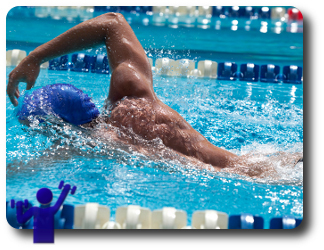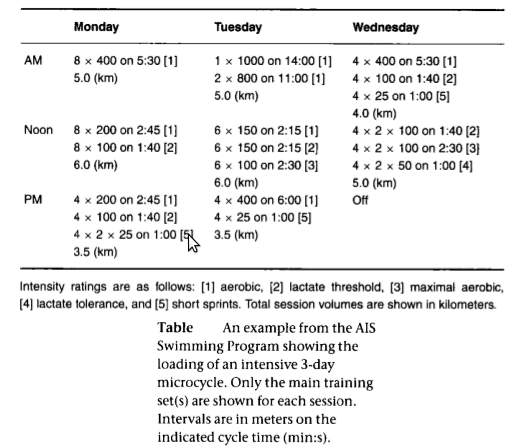A creative approach to the planning of training sessions is essential to maintain an adequate adaptation stimulus. Once the various cycles are organized within the season or yearly plan, the detailing of individual training sessions can begin.
 Some coaches make the mistake of not properly integrating speed and endurance in the training pro- gram. This is particularly evident in the endurance phase where too great an emphasis on the volume of training may impair speed. It is an oversimplification to think that only low to moderate intensity volume work is undertaken in an "endurance" week or phase, and that only speed work is done in a "speed" week. If insufficient speed work is undertaken during the endurance phase, a swimmer may pay the price later on when they are unable to reproduce race or competitive speeds. Conversely, swimmers may become overloaded and prone to fatigue, illness, and injury if they do too much speed work without the benefits of some complementary endurance training. Highly trained swimmers can use endurance training to recover from and prepare for speed training.
Some coaches make the mistake of not properly integrating speed and endurance in the training pro- gram. This is particularly evident in the endurance phase where too great an emphasis on the volume of training may impair speed. It is an oversimplification to think that only low to moderate intensity volume work is undertaken in an "endurance" week or phase, and that only speed work is done in a "speed" week. If insufficient speed work is undertaken during the endurance phase, a swimmer may pay the price later on when they are unable to reproduce race or competitive speeds. Conversely, swimmers may become overloaded and prone to fatigue, illness, and injury if they do too much speed work without the benefits of some complementary endurance training. Highly trained swimmers can use endurance training to recover from and prepare for speed training.
Three-day microcycle example
What are some approaches to loading microcycles in swimming? One method used by the Swimming Pro- gram at the Australian Institute of Sport is to systematically increase the intensity of workouts during a 3-day microcycle. The example described here is taken from a relatively intense microcycle used to target specific areas of aerobic fitness in highly trained swimmers (Table ). The basic variables of interval training (e.g., intensity, volume, duration, and frequency) are manipulated to meet the goals of each individual session and microcycle. This microcycle is for senior swimmers in good condition and may not be appropriate for age group swimmers or those returning from a layoff, injury, or illness.
Inspection of this sequence shows that the speed of training is increased systematically within each day and also across successive days (- Table -). Training three sessions a day is a big commitment but the benefits gained can be substantial. Apart from having the opportunity to undertake a larger volume of training, there is scope to incorporate all the important elements of training. This may simply involve working all the different strokes, drills, and sets. It also gives the opportunity for some creative coaching, like switching sets for individual medley, combination sets of varying distances and intensities, and trying out some new technique drills. One of the main benefits of three sessions a day is to improve the swimmer's feel of the water with more frequent exposure than is normally experienced. Three sessions a day is not new and has been used occasionally by leading coaches and swimmers.

Intensity ratings are as follows: [1] aerobic, [2] lactate threshold, [3] maximal aerobic, [4] lactate tolerance, and [5] short sprints. Total session volumes are shown in kilometers.
Day 1
On Day 1, aerobic intervals and some short sprints are undertaken for a total volume of 14.5 km (5.0 + 6.0 + 3.5). The AM session contains some 400s at an aerobic level. This work forms the basis of a highly trained swimmer's program, but some swimmers shy away from this type of work. Even sprinters should be prepared to undertake some basic endurance work. The main set of the Noon session is 8 x (200 on 2:45 [1], 100 on 1:40 [2]). (Numbers in square brackets represent intensity ratings; see - Table - for description of intensity ratings.) These cycles are for freestyle and would need to be adjusted for the form strokes. Most coaches use the approach seen here of 200s at an aerobic speed and then 100s at a slightly faster threshold speed. The shorter session in the PM contains the speed work (4 x 2 x 25 m at [5]). Again the emphasis is on increasing speed as the set progresses. Swimmers should always be able to perform fast 25s even during high volume training weeks.
Day 2
On Day 2 the same training volume as on Day 1
(14.5 km) is completed but there is more quality in the Noon session. The AM session is used to prepare the swimmers for higher quality swimming in the Noon and PM sessions. The AM session has some 800s and 1000s. These are of ten but not always done freestyle. Mixing or alternating freestyle with freestyle/backstroke by 50-, 100-, or 200-m intervals or even individual medley in normal order or reverse order is commonly seen. A good practice is to mix up these longer intervals: some should be done straight freestyle and some using a mixed approach. Many coaches and swimmers fall into the habit of doing all the work using a mixture of strokes and distances and may miss the benefits of continuous over distance freestyle swimming. There are some programs at both senior and age-group levels that do not use these longer intervals at all—this may be limiting in the long term.
The Noon session of 6 x (150 on 2:15 at [1], 150 on 2:15 at [2], 100 on 2:30 at [3]) is a useful way to introduce more quality and speed into the workouts. This is a descending set with the first 150 swum at level [1] or aerobic, the second 150 at level [2] or threshold, and the final 100 at level [3] or maximal aerobic (approximately 400 m race pace). The final 100 is on a longer cycle time (2:30) to permit some recovery before the set is repeated. This is an example of a combination set that mixes different distances and different intensities. The total distance of the set is 2400 m, which represents a solid training session for aerobic fitness. This type of work can be used in conjunction with the commonly used "heart rate" sets, which are characterized by the repetition of the same distance at equivalent or increasing intensity, e.g., 30 x 100 m on 1:40 holding 1:05 or heart rate 160190 bpm (40-10 beats below a maximum heart rate of 200 bpm). A commonly asked question by coaches is whether it is better to hold swimmers at a high heart rate and let their repeat times slip a little, or back them off to keep their heart rate under control. The most important thing is to maintain speed together with proper technique—if this means increasing the rest period or cycle time, or slowing the swimmer a little. There is no single answer here and a coach has to exercise his or her judgment as to the most appropriate action on the day.
Day 3
On Day 3, there are only two sessions for a total of 9 km. This gives the swimmers a better opportunity to attack the main Noon session. The aim here is to reduce the volume of training and concentrate on the speed (intensity). Note again how the AM session con- tains a small build-up of intensity [1-2] to prepare the swimmers for the demanding [2-3-4] Noon session. Contrast this to the AM sessions in Days 1 and 2 where only aerobic [1] work was undertaken. Using the first session to prepare a swimmer for the second session is possible where the sessions are close together and only a few hours apart.
The final Noon session of this 3-day microcycle is 4 x (2 x 100 on 1:40 [2], 2 x 100 on 2:30 [3], and 2 x 50 on 1:00 [4]). This is the most intensive session of the microcycle both in terms of effort and speed. Note that the second pair of 2 x 100 is on a longer cycle (2:30) than the first pair (1:40). The extra time is designed to support the increase in speed, i.e., 2 x 100 on 2:30 at [3] compared with 2 x 100 on 1:40 at [2]. It is expected that the 50s would be quite fast, at around 100 m race pace. Again these cycles are for freestyle and may need to be adjusted for other strokes or junior swimmers.

